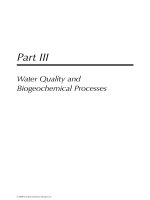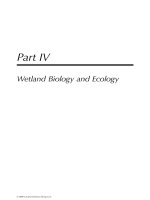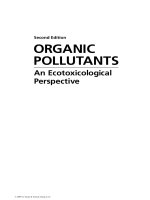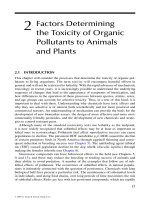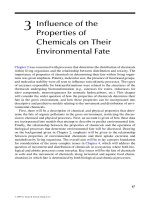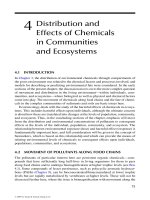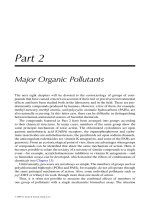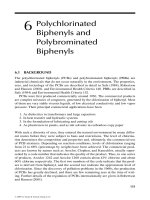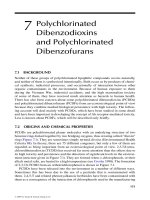ORGANIC POLLUTANTS: An Ecotoxicological Perspective - Chapter 9 potx
Bạn đang xem bản rút gọn của tài liệu. Xem và tải ngay bản đầy đủ của tài liệu tại đây (376.75 KB, 11 trang )
181
9
Polycyclic Aromatic
Hydrocarbons
9.1 BACKGROUND
Hydrocarbons are compounds composed of carbon and hydrogen alone. They may
be classied into two main groups:
1. Aromatic hydrocarbons that contain ring systems with delocalized elec-
trons, for example, benzene.
2. Nonaromatic hydrocarbons that do not contain such a ring system. Included
here are alkanes, which are fully saturated hydrocarbons; alkenes, which
contain one or more double bonds; and alkynes, which contain one or more
triple bonds.
Some examples of different types of hydrocarbons are given in Figure 9.1. Nonaromatic
compounds without ring structure are termed aliphatic, whereas those with a ring
structure (e.g., cyclohexane) are termed alicyclic. Aromatic hydrocarbons often consist
of several fused rings, as in the case of benzo[a]pyrene.
Both classes of hydrocarbon occur naturally, notably in oil and coal deposits.
Aromatic compounds are also products of incomplete combustion of organic com-
pounds, and are released into the environment both by human activities, and by
certain natural events, for example, forest res and volcanic activity.
Aromatic hydrocarbons, the subject of this chapter, are of particular concern
because of their mutagenic and carcinogenic properties. In the rst place, this raises
issues about human health risks. However, there are also questions about possible
harmful effects on ecosystems that are exposed to high levels of aromatic hydrocar-
bons. Nonaromatic hydrocarbons are usually of low toxicity, have not received much
attention in ecotoxicology, and will not be discussed further in the present text. It
should, however, be remembered that crude oil consists mainly of alkanes, and large
releases into the sea due to the wreckage of oil tankers have caused the death of
many seabirds and other marine organisms because of their physical effects of oil-
ing, or smothering (see Clark 1992). Also, released crude oil may act as a vehicle for
other lipophilic pollutants that dissolve in it, for example, organotin compounds and
PCBs, both of which may be present in or on wrecked vessels.
© 2009 by Taylor & Francis Group, LLC
182 Organic Pollutants: An Ecotoxicological Perspective, Second Edition
9.2 ORIGINS AND CHEMICAL PROPERTIES
The largest releases of polycyclic aromatic hydrocarbons (PAHs) are due to the
incomplete combustion of organic compounds during the course of industrial pro-
cesses and other human activities. Important sources include the combustion of coal,
crude oil, and natural gas for both industrial and domestic purposes, the use of such
materials in industrial processes (e.g., the smelting of iron ore), the operation of the
internal combustion engine, and the combustion of refuse (see Environmental Health
Criteria 202, 1998). The release of crude oil into the sea by the offshore oil industry
and the wreckage of oil tankers are important sources of PAH in certain areas. Forest
res, which may or may not be the consequence of human activity, are a signicant
2
1
45
Tetracene
Pyrene
Chrysene
Aromatic
Non-aromatic
Coronene
Fluoranthene
Benzo(a)pyreneNaphthalene
Propane
Cyclohexane
67
10 11 12
12 1
2
3
4
5
67
8
9
1
2
6
710
98
5
34
10
11
8
5
4
3
2
11
2
3
4
5
67
8
9
10
11
12
10
9
8 6
7
9
3
CCC
C
C
C
C
C
C
HH
HHH
HHH
H
H
H
H
HH
HH
H
H
H
H
FIGURE 9.1 Structures of some hydrocarbons.
© 2009 by Taylor & Francis Group, LLC
Polycyclic Aromatic Hydrocarbons 183
and usually unpredictable source of PAH. In general, environmental contamination
is by complex mixtures of PAHs, not by single compounds.
The structures of some PAHs of environmental interest are given in Figure 9.1.
Naphthalene is a widely distributed compound consisting of only two fused benzene
rings. It is produced commercially for incorporation into mothballs. Many of the
compounds with marked genotoxicity contain 3–7 fused aromatic rings. Benzo[a]
pyrene is the most closely studied of them, and will be used as an example in the
following account.
Because of the fusion of adjacent rings, PAHs tend to have a rigid planar struc-
ture. As a class, they are of low water solubility and marked lipophilicity and have
high octanol–water coefcients (K
ow
) (Table 9.1); the higher the molecular weight,
the higher the lipophilicity, and the higher the log K
ow
. Vapor pressure is also related
to molecular weight; the higher the molecular weight, the lower the vapor pres-
sure. PAHs have no functional groups and are chemically rather nonreactive. They
can, however, be oxidized both in the natural environment and biochemically (see
Figure 9.2). Photodecomposition can occur in air and sunlight to yield oxidative
products, such as quinones and endoperoxides. Nitrogen oxides and nitric acid can
convert PAHs to nitro derivatives, whereas sulfur oxides and sulfuric acids can pro-
duce sulfanilic and sulfonic acids.
9.3 METABOLISM
Because of the absence of functional groups, primary metabolic attack on PAHs is
limited to oxidation, usually catalyzed by cytochrome P450. As with coplanar PCBs,
oxidative attack involves P450 forms of more than one gene family, including mem-
bers of gene families 1, 2, and 3. The position of oxidative attack on the ring system
(regioselectivity) depends on the P450 form to which a PAH is bound. P450 1A1 is
particularly implicated in the metabolic activation of carcinogens, such as benzo[a]
pyrene, where oxygen atoms can be inserted into the critical bay region positions.
The metabolism of benzo[a]pyrene has been studied in some depth and detail, and
will be used as an example of the metabolism of PAHs more generally (Figure 9.2).
TABLE 9.1
Properties of Some Polycyclic Aromatic Hydrocarbons
Compound
Vapor Pressure
(Pa @ 25°C) log K
ow
Water Solubility
at 25°C μg/L
Naphthalene 10.4 3.4 3.17 × 10
−4
Anthracene 8.4 × 10
−4
4.5 73
Pyrene 6.0 × 10
−4
5.18 135
Chrysene 8.4 × 10
−5
5.91 2.0
Benzo[a]pyrene 7.3 × 10
−7
6.50 3.8
Dibenz[a,h]anthracene 1.3 × 10
−8
6.50 0.5
Source: From Environmental Health Criteria 202.
© 2009 by Taylor & Francis Group, LLC
184 Organic Pollutants: An Ecotoxicological Perspective, Second Edition
Initial metabolic attack can be upon one of a number of positions on the benzo[a]
pyrene molecule to yield various epoxides. Epoxides tend to be unstable and can
quickly rearrange to form phenols. They may also be converted to transdihydrodiols
by epoxide hydrolase, or to glutathione conjugates by the action of glutathione-S-
transferases. Hydroxymetabolites are more polar than the parent molecules, and can
be converted into conjugates, such as glucuronides and sulfates, by the action of
conjugases. Two important oxidations of benzo[a]pyrene are shown in Figure 9.2:
formation of the 7,8 oxide and the 4,5 oxide. The 4,5 oxide is unstable under cellular
conditions, undergoing rearrangement to form a phenol, and biotransformation to a
transdihydrodiol or a glutathione conjugate. In vitro, it shows mutagenic properties,
for example, in the Ames test. However, in vertebrates in vivo, it appears to be detoxi-
ed very effectively, thus preventing the formation of DNA adducts to any signicant
degree. The 7,8 oxide is converted to the 7,8 transdihydrodiol by the action of epox-
ide hydrolase. The 7,8 transdihydrodiol is a substrate for P450 1A1, and consequent
oxidation yields the highly mutagenic 7,8 diol, 9,10 oxide, a metabolite that, under
cellular conditions, interacts with guanine residues of DNA. Thus, a mutagenic diol
epoxide generated in the endoplasmic reticulum is able to escape detoxication in
situ, or elsewhere in the cell, as it migrates to the nucleus to interact with DNA. This
ability to escape full detoxication may be related to the fact that the isomer of the 7,8
diol 9,10 oxide responsible for adduction (Figure 9.2) is a poor substrate for epoxide
hydrolase. It should be added that benzo[a]pyrene is an inducer of P450 1A1, so it can
increase the rate of its own activation! The toxicological signicance of this type of
interaction will be discussed in Section 9.5.
In terrestrial animals, the excreted products of PAHs are mainly conjugates
formed from oxidative metabolites. These include glutathione conjugates of epox-
ides, and sulfate and glucuronide conjugates of phenols and diols.
PAHs, such as benzo[a]pyrene and 3-methyl cholanthrene, induce P450 1A1/2
(Chapter 2).
9
8
7 6 5
Benzo(a)pyrene (BP) BP oxide (4,5) (K region)
4
MO
MO
Trans-diol
G-SH
conjugate
Phenol
10
9
8
O
7
7,8-oxide BP 7,8-trans-diol BP 7,8-trans-diol
9,10-oxide
is form
binds to DNA
H
H
OH
8
7
9
10
O O H
10
EH MO
O
4
5
9
8
HO
OH
7
10
9
8
HO
OH
7
10
O
FIGURE 9.2 Metabolism of benzo[a]pyrene.
© 2009 by Taylor & Francis Group, LLC
Polycyclic Aromatic Hydrocarbons 185
Induction of P450 1A1/2 provides the basis for biomarker assays for PAHs and
other planar organic pollutants, such as coplanar PCBs, PCDDs, and PCDFs.
9.4 ENVIRONMENTAL FATE
Viewed globally, the largest emissions of PAH are into the atmosphere, and the main
source is the products of incomplete combustion of organic compounds. As men-
tioned earlier, emissions are mainly the consequence of human activity, although
certain natural events, for example, forest res, are sometimes also important.
Emissions into the air are of complex mixtures of different PAHs, including particu-
late matter, as in smoke. PAHs in the vapor phase can be adsorbed on to airborne
particles. Airborne PAHs eventually enter surface waters owing to precipitation of
particles or to diffusion. Once there, because of their high K
ow
values, they tend to
become adsorbed to the organic material of sediments, and are taken up by aquatic
organisms. Similarly, airborne PAH can eventually reach soil to become adsorbed by
soil colloids, and absorbed by soil organisms.
Apart from release into air, which is important globally, the direct transfer of
PAH to water or land surfaces can be very important locally. Wreckages of oil tank-
ers and discharges from oil terminals cause marine pollution by crude oil, which
contains appreciable quantities of PAH. Disposal of waste containing PAH around
industrial premises has caused serious pollution of land in some localities.
When crude oil is released into the sea, oil lms (slicks) can spread over a large
area, the extent and direction of movement being determined by wind and tide (see
Clark 1992). The hydrocarbons of lowest molecular weight have the highest vapor
pressures, and tend to volatilize, leaving behind the least volatile components of
crude oil. Eventually, the residue of relatively involatile hydrocarbons will sink to
become associated with sediment. Thus, long after the surface lm of oil has disap-
peared, residues of PAH will exist in sediment, where they are available to bottom-
dwelling organisms. To illustrate the range of PAHs found in sediments, some values
follow for PAH residues detected in sediment from the highly polluted Duwamish
waterway in the United States (see Varanasi et al. 1992). All concentrations are given
as mean values expressed as ng/g dry weight.
Naphthalene 400
Fluorene 390
Phenanthrene 2400
Anthracene 610
Fluoranthene 3900
Benz[a]anthracene 2000
Chrysene 2900
Benzo[a]pyrene 2300
Pyrene 4800
Dibenz[a,h]anthracene 470
Perylene 900
Benzouoranthenes 4900
© 2009 by Taylor & Francis Group, LLC
186 Organic Pollutants: An Ecotoxicological Perspective, Second Edition
PAHs can be bioconcentrated or bioaccumulated by certain aquatic invertebrates
low in the food chain that lack the capacity for effective biotransformation (Walker
and Livingstone 1992). Mollusks and Daphnia spp. are examples of organisms that
readily bioconcentrate PAH. On the other hand, sh and other aquatic vertebrates
readily biotransform PAH; so, biomagnication does not extend up the food chain
as it does in the case of persistent polychlorinated compounds. As noted earlier,
P450-based monooxygenases are not well represented in mollusks and many other
aquatic invertebrates (see Chapter 4, Section 4.2); so, this observation is not surpris-
ing. Oxidation catalyzed by P450 is the principal (perhaps the only) effective mecha-
nism of primary metabolism of PAH.
An example of PAH residues in polluted marine ecosystems is given in Table 9.2.
They are from studies carried out at different coastal sites of the United States
(Varanasi et al. 1992). The residues are categorized into “lower aromatic hydrocar-
bons (LAH),” composed of 1–3 rings, and “higher aromatic hydrocarbons (HAH),”
composed of 4–7 rings. HAHs predominate in sediment, showing levels in the range
1,800–12,600 ng/g, that is, 1.8–12.6 ppm by weight. As mentioned earlier, some
invertebrates can bioaccumulate PAH, which is the main reason for signicant levels
of PAH in the remains of food found within sh stomachs. Analysis of invertebrates
from some of these areas showed levels of 300–3500 ng/g total aromatic hydrocar-
bon in their tissues, of which over 90% was accounted for as HAH. The concen-
trations of aromatic hydrocarbons are, however, substantially below those found in
samples of sediment. Thus, HAH levels range from 135 to 2700 ng/g in stomach
contents. Interestingly, no residues of aromatic hydrocarbons were detected in the
livers of the sh analyzed in this study, illustrating their ability to rapidly metabolize
both LAH and HAH.
It appears that organisms at the top of aquatic food chains are not exposed to
substantial levels of PAH in food because of the detoxifying capacity of organisms
beneath them in the food chain. On the other hand, sh, birds, and aquatic mammals
feeding on mollusks and other invertebrates are in a different position. Their food
may contain substantial levels of PAH. Although they can achieve rapid metabo-
lism of dietary PAH, it should be remembered that oxidative metabolism causes
TABLE 9.2
Concentration of Aromatic Hydrocarbons (AHs) in Samples
from U.S. Coastal Sites
Sample
Total AH
(ng/g)
1–3 Rings (LAH)
(ng/g)
4–7 Rings (HAH)
(ng/g)
Sediments 700–14,000 200–1,400 1,800–12,600
Fish stomach 150–3,000 15–300 135–2,700
Contents — — —
Fish liver Nil Nil Nil
Source: Extracted from data presented by Varanasi et al. (1992).
© 2009 by Taylor & Francis Group, LLC
Polycyclic Aromatic Hydrocarbons 187
activation as well as detoxication. The types of P450 involved determine the position
of metabolic attack (see Section 9.3). Cytochrome P450 1A1, for example, activates
benzo[a]pyrene by oxidizing the bay region to form a mutagenic diol epoxide. The
tendency for PAHs to be activated as opposed to detoxied depends on the balance
of P450 forms, and this balance is dependent on the state of induction. Many PAHs,
PCDDs, PCDFs, coplanar PCBs, and other planar organic pollutants are inducers
of P450s belonging to Family 1A. Thus, activation of PAH may be enhanced owing
to the presence of pollutants that induce P450 1A1/1A2, forms that are particularly
implicated in the process of activation (Walker and Johnston 1989).
9.5 TOXICITY
PAHs are rather nonreactive in themselves, and appear to express little toxicity.
Toxicity is the consequence of their transformation into more reactive products, by
chemical or biochemical processes. In particular, the incorporation of oxygen into
the PAH ring structure has a polarizing effect; the electron-withdrawing properties
of oxygen leading to the production of reactive species such as carbonium ions. This
is evidently the reason why PAHs become more toxic to sh and Daphnia following
exposure to ultraviolet (UV) radiation (Oris and Giesy 1986, 1987); photooxidation
of PAH to reactive products increases toxicity.
Much research on the toxicity of PAH has been concerned with human health
hazards, and has focused on their mutagenic and carcinogenic action. These two
properties are to some extent related, because there is growing evidence that cer-
tain DNA adducts formed by metabolites of carcinogenic PAHs become xed as
mutations of oncogenes or tumor-suppressor genes that are found in chemically pro-
duced cancers (Purchase 1994). Typical mutations occur at specic codons in the ras,
neu, or myc oncogenes or in P53, retinoblastoma or APC tumor suppressor genes.
These genes code for proteins involved in growth regulation, with the consequence
that mutated cells have altered growth control. One example of such a carcinogenic
metabolite is the 7,8-diol-9,10 oxide of benzo[a]pyrene (Figure 9.2). More generally,
many compounds found to be mutagenic in bacterial mutation assays (e.g., the Ames
test) are also carcinogenic in long-term dosing tests with rodents. However, a sub-
stantial number of carcinogens act by nongenotoxic mechanisms (Purchase 1994).
Benzo[a]pyrene is converted to its 7,8-diol-9,10 oxide by the action of cytochrome
P450 1A1 and epoxide hydrolase, as shown in Figure 9.2. In one of its enantiomeric
forms, this metabolite can then form DNA adducts by alkylating certain guanine
residues (Figure 9.3). The metabolite acts as an electrophile, due to strong carbo-
nium ion formation on the 10 position of the epoxide ring, which is located in the
bay region. The epoxide ring cleaves, and a bond is formed between C10 of the PAH
ring and the free amino group of guanine. The oxygen atom of the cleaved epoxide
ring acquires a proton, thus leaving a hydroxyl group attached to C9. This adduct,
similar to the others formed between reactive metabolites of PAHs and DNA, is
bulky and can be detected by P32 postlabeling and immunochemical techniques
(e.g., Western blotting). It has been proposed that there is a particular tendency for
strong carbonium ion formation to occur on the bay region of PAHs, and that such
© 2009 by Taylor & Francis Group, LLC
188 Organic Pollutants: An Ecotoxicological Perspective, Second Edition
“bay region epoxides” have a strong tendency to form DNA adducts (see Hodgson
and Levi 1994) .
There is strong evidence that DNA adduction by these bulky reactive metabolites
of PAHs is far from random, and that there are certain “hot spots” that are preferen-
tially attacked. Differential steric hindrance and the differential operation of DNA
repair mechanisms ensure that particular sites on DNA are subject to stable adduct
formation (Purchase 1994). DNA repair mechanisms clearly remove many PAH/
guanine adducts very quickly, but studies with P
32
postlabeling have shown that cer-
tain adducts can be very persistent—certainly over many weeks. Evidence for this
has been produced in studies on sh and Xenopus (an amphibian; Reichert et al.
1991; Waters et al. 1994).
Although genotoxicity is of central importance in human toxicology, its signi-
cance in ecotoxicology is controversial. However, PAH has been shown to cause
tumor development in sh in response to, for example, oral, dermal, or intraperito-
neal administration of benzo[a]pyrene and 3-methyl cholanthrene. Hepatic tumors
have been reported in wild sh exposed to sediment containing about 250 mg/kg of
PAH (Environmental Health Criteria 202). K-ras mutations occurred in pink salmon
embryos (Onchorhynchus gorbuscha) following exposure to crude oil from the
tanker Exxon Valdez, which caused extensive pollution of coastal regions of Alaska
(Roy et al. 1999). However, it is not clear whether cancer is a signicant factor in
determining the survivorship or reproductive success of free-living vertebrates or
invertebrates. Cancers usually take a long time to develop, and the life span of free-
living animals is limited by factors such as food supply, disease, predation, etc. Do
they live long enough for cancers to be a signicant cause of population decline?
Apart from carcinogenicity, there is the wider question of other possible genotoxic
effects in free-living animals, effects that may be heritable if the mutations are in
germ cells. Studying aquatic invertebrates exposed to PAH, Kurelec (1991) noticed a
number of longer-term physiological effects, which he termed collectively genotoxic
disease syndrome. Although the basis for these effects has not yet been elucidated,
the observations raise important questions that should be addressed. PAHs have been
shown to form a variety of adducts in sh and amphibians, so there is a strong suspi-
cion that some of these may lead to the production of mutations. If mutations occur
O
NH
N
N
N
NH
10
9
8
7
R
HO
HO
OH
Attachment of BP 7,8-diol 9,10-oxide
to guanine residue of DNA
FIGURE 9.3 DNA adduct formation.
© 2009 by Taylor & Francis Group, LLC
Polycyclic Aromatic Hydrocarbons 189
in germ cells, there are inevitably questions about their effects on progeny. Most
mutations are not benecial!
There is evidence for immunosuppressive effects of PAHs in rodents (Davila et
al. 1997). For example, strong immunosuppressive effects were reported in mice
that had been dosed with benzo[a]pyrene and 3-methyl cholanthrene, effects that
persisted for up to 18 months (Environmental Health Criteria 202). Multiple immu-
notoxic effects have been reported in rodents, and there is evidence that these result
from disturbance of calcium homeostasis (Davila et al. 1997). PAHs can activate
protein tyrosine kinases in T cells that initiate the activation of a form of phospholi-
pase C. Consequently, release of inositol triphosphate—a molecule that immobilizes
Ca
2+
from storage pools in the endoplasmic reticulum—is enhanced.
Turning to the acute toxicity of PAH, terrestrial organisms will be dealt with
before considering aquatic organisms, to which somewhat different considerations
apply. The acute toxicity of PAHs to mammals is relatively low. Naphthalene, for
example, has a mean oral LD50 of 2700 mg/kg to the rat. Similar values have been
found with other PAHs. LC50 values of 150 mg/kg and 170–210 mg/kg have been
reported, for phenanthrene and uorene, respectively, in the earthworm. The NOEL
level for survival and reproduction in the earthworm was estimated to be 180 mg/
kg dry soil for benzo[a]pyrene, chrysene, and benzo[k]uoranthene (Environmental
Health Criteria 202).
Toxicity of PAH to aquatic organisms depends on the level of UV radiation to
which the test system is exposed. PAHs can become considerably more toxic in the
presence of radiation, apparently because photooxidation transforms them into toxic
oxidative products. PAHs, such as benzo[a]pyrene, can have LC50s as low as a few
micrograms per liter toward sh when there is exposure to UV (Oris and Giesy 1986,
1987). PAHs can also show appreciable toxicity to sediment-dwelling invertebrates.
LC50 values of 0.5–10 mg/kg (concentration in sediment) have been reported for
marine amphipods for benzo[a]pyrene, uranthene, and phenanthrene, used singly
or in mixtures. These values are much lower than the LC50 or NOEL concentrations
for earthworms quoted earlier, which were exposed to contaminated soil. It has also
been shown that exposure of adult sh to anthracene and articial UV radiation can
impair egg production (Hall and Uris 1991).
9.6 ECOLOGICAL EFFECTS
Serious ecological damage has been caused locally by severe oil pollution. The wreck-
ages of the oil tankers—the Torrey Canyon (Cornwall, United Kingdom, 1967), the
Amoco Cadiz (Brittany, France, 1978), the Exxon Valdez (Alaska, United States,
1989), and the Sea Empress (South Wales, United Kingdom, 1996)—all caused seri-
ous pollution locally. Less dramatically, leakage from offshore oil operations has
also caused localized pollution problems. Most of the reported harmful effects of
such marine pollution have been due to the physical action of the oil rather than the
toxicity of PAHs. Fish, however, may have been poisoned by oil in situations where
there was strong UV radiation (see Section 9.5). The oiling of seabirds and other
marine organisms has been the cause of some local population declines. Sometimes
the reduction of invertebrate herbivores on polluted beaches and rock pools has led
© 2009 by Taylor & Francis Group, LLC
190 Organic Pollutants: An Ecotoxicological Perspective, Second Edition
to an upsurge of the plants upon which they feed. The ourishing of seaweeds and
algal blooms has sometimes followed such environmental disasters, to be reversed
when pollution is reduced and the herbivores recover. In the neighborhood of oil ter-
minals the diversity of benthic fauna has been shown to decrease (see Clark 1992).
Although it has been relatively easy to demonstrate local short-term effects of oil
pollution on seabird populations, establishing longer-term effects on marine ecosys-
tems has proved more difcult, notwithstanding the persistence of PAH residues in
sediments. In one study, the edible mussel (Mytilus edulis) was used as an indicator
organism to investigate PAH effects along a pollution gradient in the neighborhood
of an oil terminal at Sullom Voe, Shetlands, United Kingdom (Livingstone et al.
1988). The impact of PAH was assessed using a suite of biomarker assays. One of
the assays was “scope for growth,” an assay that seeks to measure the extra available
energy of the organism that can be used for growth and reproduction: extra, that is, in
relation to the basic requirement for normal metabolic processes. A strong negative
relationship was shown between scope for growth and the tissue concentration of 2-
and 3-ring PAHs (Figure 9.4). Although this observation might be criticized on the
grounds that other pollutants could have followed the same pollution gradient and
had similar effects upon scope for growth, there was some supporting evidence from
a controlled mesocosm study, which showed a similar dose–response relationship
over part of the range, and gave a similar regression line. Also, controlled laboratory
studies with M. edulis showed that scope for growth could be reduced by dosing with
diesel oil to give tissue levels of 2- and 3-ring PAH similar to those found in the eld
study. In addition to the reduction in scope for growth, some biomarker responses
(
"
$"
#" !&
!!
!!#" "
"$" "% !'$""!!#
FIGURE 9.4 Relationship between scope for growth and whole tissue concentration of 2-
and 3-ring aromatic hydrocarbons in Mytilus edulis (mean ±95% condence limits). N, Data
from Solbergstrand mesocosm experiment, Oslo Fjord, Norway. D, Data from Sullom Voe,
Shetland Islands (Moore et al. 1987).
© 2009 by Taylor & Francis Group, LLC
Polycyclic Aromatic Hydrocarbons 191
were observed (Livingstone 1985). The lowest level of dosing with diesel oil (29 ppb
for 4 months) caused a doubling of P450 levels, a reduction in lysosomal stability,
and an increase in cytochrome P450 reductase. Thus, strong evidence was produced
for the harmful effects of PAH on M. edulis near an oil terminal, but it was not estab-
lished whether these were sufcient to cause a population decline.
As discussed earlier (see Chapter 6, Section 6.2.5), several studies have linked the
presence of high PAH levels in the marine environment with a high incidence of tumors
in sh. The ecological signicance of these observations, however, is not known.
9.7 SUMMARY
On the global scale, most PAH release is the consequence of incomplete combustion
of organic compounds. In the marine environment, however, there can be signicant
levels of PAH pollution locally, due to the large-scale release of crude oil—especially
due to the wreckage of oil tankers, but also to leakage of crude oil during offshore
oil operations. PAHs can be biomagnied by some aquatic invertebrates, but not in
organisms higher in the food chain in which they are relatively rapidly metabolized.
PAHs do not have high acute toxicity to terrestrial animals. To sh, however,
they can show considerable toxicity in the presence of UV light, as a consequence
of their photooxidation. In human toxicology, the main concern has been about the
mutagenic and carcinogenic properties of some PAHs. The metabolic activation of
such compounds leads to the formation of DNA adducts, which can be stabilized as
mutations of oncogenes or tumor suppressor genes, genes that have a role in growth
regulation. There is growing evidence that PAHs can also form DNA adducts in
wild vertebrates; however, there is controversy about the signicance of this from an
ecological point of view. PAHs cause the induction of P450 1A1/2, a response that
has been utilized in the development of biomarker assays for these and other planar
lipophilic organic pollutants.
FURTHER READING
Clark, R.B. (1992). Marine Pollution, 3rd edition, Clarendon Press, Oxford—Offers a read-
able account of marine pollution caused by crude oil, but does not deal with biochemical
aspects.
Environmental Health Criteria 202 (1998). WHO, Geneva—Gives a very detailed account of
the environmental toxicology of PAHs seen from the global point of view. However, it
largely ignores marine pollution caused by oil spills.
© 2009 by Taylor & Francis Group, LLC

